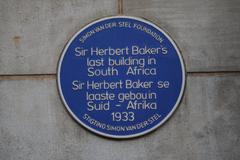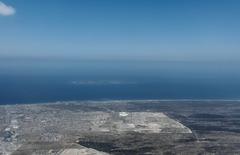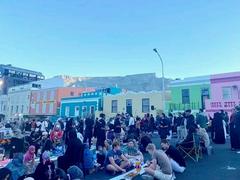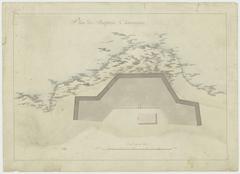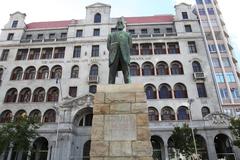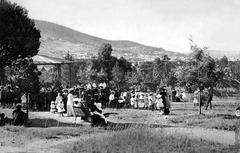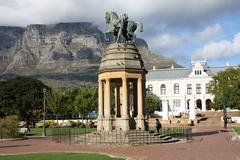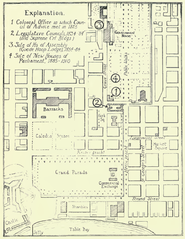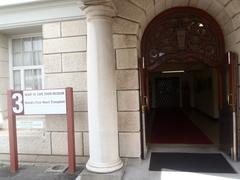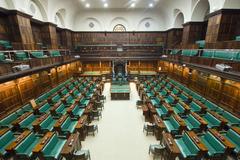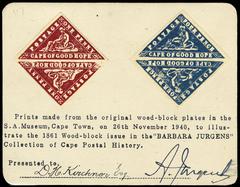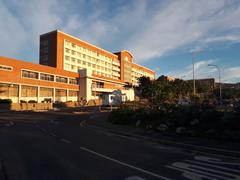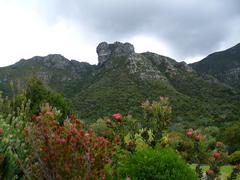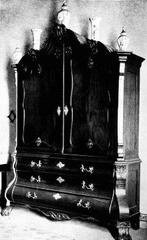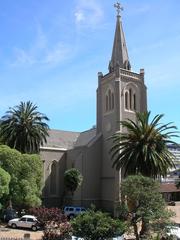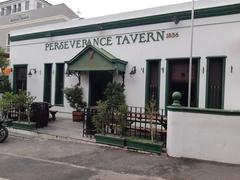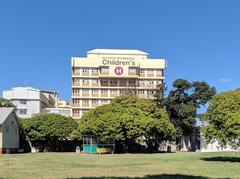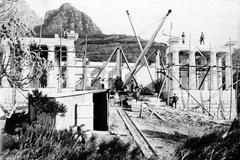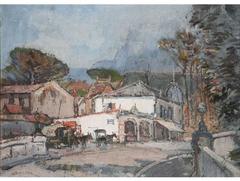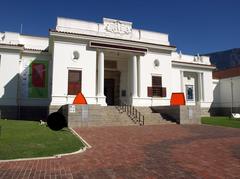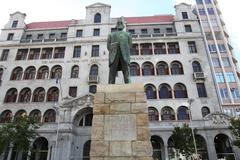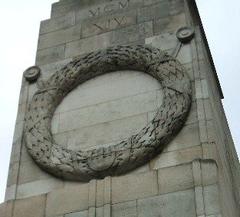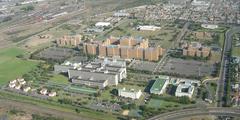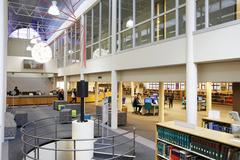
Barclays Bank Building Cape Town: Visiting Hours, Tickets, and Historical Significance
Date: 14/06/2025
Introduction
Nestled in the heart of Cape Town’s central business district, the Barclays Bank Building stands as a monument of architectural grandeur and historical significance. Completed in 1934, this iconic structure represents the last major South African commission by renowned architect Sir Herbert Baker. Blending classical European design with indigenous materials, the building captures the economic optimism and imperial aspirations of early 20th-century Cape Town. Today, it is a compelling destination for architecture enthusiasts, history buffs, and cultural travelers alike, offering insight into the city’s evolving financial sector and colonial legacy (The Heritage Portal).
This guide provides detailed information for visitors, including historical context, architectural highlights, practical tips, accessibility, and recommendations for engaging with nearby heritage sites.
Historical Context and Baker’s Legacy
The Barclays Bank Building marks the culmination of Sir Herbert Baker’s influential career in South Africa. Baker’s architectural journey began with small-scale projects and evolved into landmark commissions such as the Union Buildings in Pretoria and Rhodes Memorial. His final Cape Town project, the Barclays Bank Building, was constructed during a period of economic optimism and intended to symbolize both financial stability and imperial ambition (The Heritage Portal).
A commemorative blue plaque, installed by the Heritage Association of South Africa, recognizes the building’s architectural and historical value. Baker’s approach—melding European classical traditions with local materials—helped shape the built environment of Cape Town and left a lasting impression on South African architecture.
Architectural Significance and Features
Exterior Design
- Granite Base: The building’s sturdy foundation features cushion rusticated granite, reflecting strength and durability.
- White Mountain Stone Façade: The main façade is clad in stone sourced from Ceres, emphasizing the use of South African materials.
- Columns and Entrances: Massive columns crafted in Paarl and stately bronze entrance doors create a commanding street presence.
- Window Detailing: Bronze-framed street-level windows transition to teak-framed windows on upper floors, showcasing craftsmanship and material contrast.
Interior Spaces
- Banking Hall: The iconic dome is lined with Italian travertine and finished with acoustic plaster for superior sound control.
- Flooring and Paneling: Floors feature Italian and German travertine inlaid with Belgian marble. Indigenous stinkwood paneling and furniture infuse local character, while bronze fittings add to the building’s prestige.
- Structural Innovations: Built on a steel framework, the structure incorporates advanced construction techniques of its era. The foundation rests on solid bedrock, providing a dry substructure that distinguishes it among Adderley Street’s historic buildings.
Visiting Hours, Tickets, and Access
Visiting Hours
- Exterior Viewing: The building’s impressive exterior can be admired at any time during daylight hours.
- Interior Access: As the building now functions as a bank headquarters (First National Bank), interior access is restricted and subject to current security policies. Guided heritage tours may occasionally include interior visits—check with local tour operators or the Heritage Association of South Africa for availability (The Heritage Portal).
Tickets
- Admission: No tickets are required to view the exterior. Guided tours that include interior access may charge a fee.
Accessibility
- Location: Situated on Adderley Street, the building is easily reached by public transport, including the MyCiTi bus and Cape Town railway station.
- Mobility: The surrounding area is pedestrian-friendly, but as an older structure, full interior accessibility may be limited. Visitors with mobility needs should contact tour operators in advance for details.
Travel Tips and Local Etiquette
- Best Time to Visit: Early mornings and late afternoons on weekdays offer optimal lighting for photography and fewer crowds.
- Safety: The CBD is generally safe during the day. Standard urban precautions apply—avoid displaying valuables and be cautious with parked vehicles (The Unconventional Route).
- Amenities: Adderley Street features cafes, shops, and restaurants. The nearby Company’s Garden offers a tranquil spot for a stroll.
- Tipping: A 10% gratuity is customary in restaurants; small change for parking attendants is appreciated.
Nearby Attractions
Enhance your heritage experience by visiting these nearby sites:
- St George’s Cathedral: Another Baker masterpiece and the oldest cathedral in southern Africa (St George’s Cathedral).
- Company’s Garden: Historic botanical gardens ideal for relaxation (Company’s Garden).
- Mutual Heights: An Art Deco landmark with a striking façade.
- Castle of Good Hope and City Hall: Explore the city’s colonial and Edwardian history.
Guided Tours and Events
Local heritage organizations periodically offer walking tours that include the Barclays Bank Building and other Herbert Baker sites. These tours provide expert historical commentary and, on occasion, interior access (The Heritage Portal). Check their websites for schedules and booking information.
Photography and Etiquette
- Photography: Exterior photography is encouraged, especially during early morning or late afternoon. Interior photography is restricted and only permitted with authorization during special tours.
- Respect: As the building remains an operational bank, visitors should avoid disrupting business activities and always seek permission before entering non-public areas.
Frequently Asked Questions (FAQ)
Q: Do I need a ticket to visit the Barclays Bank Building?
A: No tickets are needed to view the exterior. Interior access is generally by arrangement during guided tours.
Q: What are the visiting hours?
A: Exterior viewing is possible during daylight hours. Interior access is usually limited to scheduled tours.
Q: Is the building accessible to wheelchair users?
A: The area is pedestrian-friendly, but full accessibility inside may be limited due to the building’s age. Check with tour operators for specifics.
Q: Are guided tours available?
A: Yes, local heritage organizations periodically offer walking tours that feature the building.
Q: Can I take photographs inside?
A: Interior photography is generally not allowed unless approved during special tours.
Recommendations for an Enriching Visit
- Combine with Other Heritage Sites: Incorporate visits to nearby landmarks such as the Mandela Rhodes Building and Mutual Heights.
- Join a Guided Tour: Gain deeper insight into architectural and historical context from local experts.
- Explore Multicultural Districts: Stroll through neighborhoods like Bo-Kaap to experience Cape Town’s diverse cultural heritage (Nomad Africa Magazine).
- Use the Audiala App: Download for guided audio tours and interactive maps.
Visuals and Media
Seek out high-quality images and virtual tours on heritage and tourism websites. When sharing photos, use alt text with keywords such as “Barclays Bank Building Cape Town,” “Herbert Baker architecture,” and “Cape Town historical sites” to enhance accessibility and searchability.
Additional Visitor Information
- Currency: Credit cards widely accepted; cash is handy for tips (The Unconventional Route).
- Transport: Uber, taxis, MyCiTi bus, and Metrorail offer convenient options.
- Tourist Resources: Free guidebooks are available at local information centers.
Plan Your Visit
The Barclays Bank Building stands as a testament to Sir Herbert Baker’s architectural mastery and the historical forces that shaped Cape Town. Whether you’re admiring its imposing granite façade or exploring the city’s broader heritage, this landmark offers a unique window into South Africa’s past. Plan your visit, join a guided tour, and leverage resources like the Audiala app to maximize your experience.
For more on Cape Town’s architectural treasures and travel tips, browse our related articles and follow us on social media for updates on tours, events, and heritage content.
References
- Commemorating Sir Herbert Baker’s Last Building in South Africa, 2023, The Heritage Portal (The Heritage Portal)
- Visiting the Mandela Rhodes Building in Cape Town: History, Tickets, and Sightseeing Tips, 2024, SA-Venues (SA-Venues)
- Herbert Baker Architecture: The Bedrock of South Africa’s Civic Grandeur, 2023, South Africa.net (South Africa.net)
- Architectural Heritage of Cape Town: A Stroll Through History, 2024, Nomad Africa Magazine (Nomad Africa Magazine)
- St George’s Cathedral History, 2023, St George’s Cathedral (St George’s Cathedral)
- Company’s Garden, 2024, City of Cape Town (Company’s Garden)
